FROM THE THIRD TO THE LIFE DYNASTY:
The Old Empire represents the first brilliant, creative and harmonious period of ancient Egypt. It lasts almost 500 years.
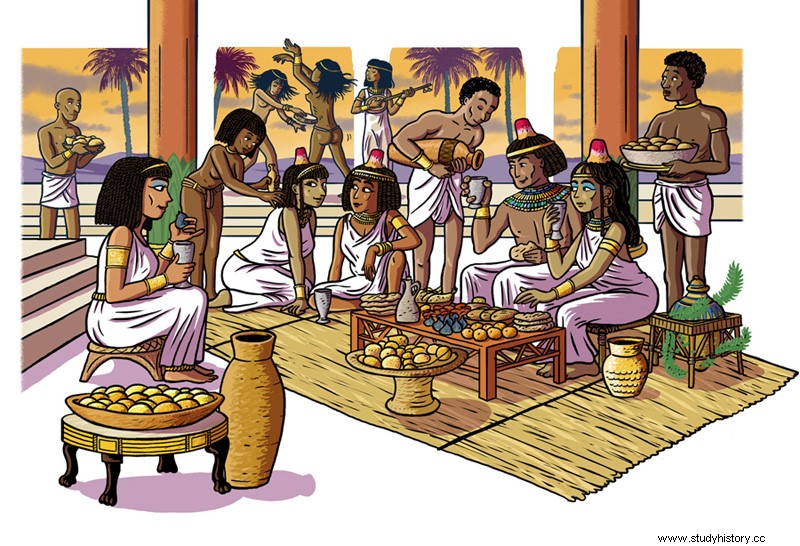
Life in ancient Egypt:
Most houses have only one or two rooms, but the wealthy live in large, luxurious villas. They often give large receptions, with drinks and food in abundance, musicians, singers, dancers and acrobats. The servants fix on the heads of the guests cones of scented fat.
Egyptians hunt, fish, practice wrestling, fencing, etc. With regard to agriculture , wheat and barley, which the Egyptians make bread and beer, are the main crops. But they also grow grapes and pomegranates which they use to make wine. They raise animals, but as grasslands are scarce in Egypt, these generally remain in the stable. Many people work in the temple of the city where they live:craftsmen, sculptors, carpenters, potters, weavers, scribes, etc. In the temple there is also a school and a few boys from wealthy families come here to learn to read and write. Older boys can study history here , geography , the religion , the languages , mathematics and medicine . The girls do not go to school, but learn at home with their mother. The peasants are forced to work on the fields of the pharaohs during the Nile floods , and they are only paid in bread and beer.
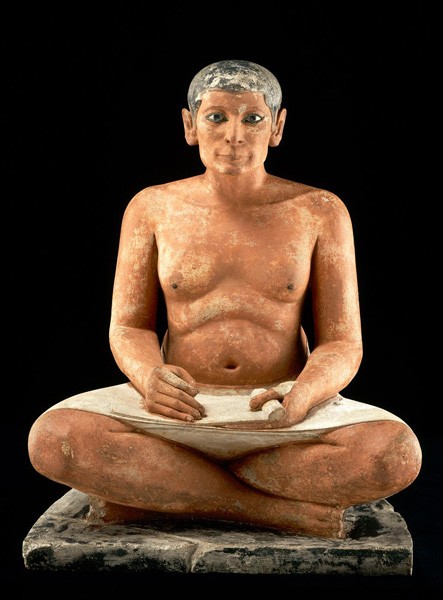
Ramp-up of centralized administration:
To ensure the unity of the people, the stability of the country and the respect of religious beliefs, the pharaohs set up a centralized administration system called status and which is composed of:
– Of Pharaoh himself:He proclaims himself first servant and vicar of the gods themselves, supreme priest, principal administrator and chief of the armies.
– Of the vizier :He is nominated by the Pharaoh and plays the role of supreme judge, head of administration, responsible for the country's economy, mainly agricultural and artisanal.
– Many “chiefs ”:Head of the Double-Grenier, head of the fields, etc.
– From officials subordinates (called nomarchs ) and scribes :They collect taxes, maintain peace and order and keep track of everything. The pharaoh lends them properties, land (which they have peasants exploit) and temples as payment for their services. This also allows him to ensure that his followers have enough resources to honor his cult after his death.
Social and cultural development:
With the establishment of centralized administration, the economy is productive and stable. Harvests are often surplus and they make it possible to:
– Finance mining operations and extractions (The lands of Egypt contain many gold mines).
– Build many collective places .
– Improve farming techniques.
– Financing works of art exceptional.
– Build colossal monuments .
– Improving business relationships .
– Improve the army .
– Have better dominance over the country .
Egyptians also master:
– Surveying :Geometric technique for measuring the area of land owned by a man. Taxes are levied based on this area.
– TheMathematics .
– Medicine .
– The making of ships . The first known ships are Egyptian. They are the best way to travel in the country because the roads are few.
– The earthenware .
– The literature .
– The art .
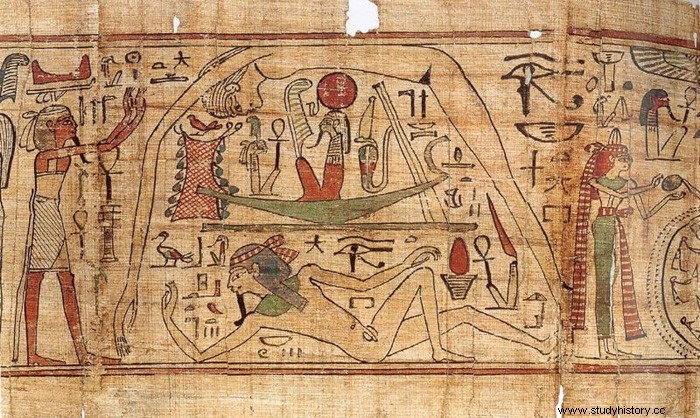
Temples and religion:
The Egyptians build gigantic stone temples on the banks of the Nile in which, they believe, the gods live and the goddesses that they revere. Each region has its own protective deity and each temple houses the statue of the god who inhabits it. Every morning, the priests awaken the god, wash the statue, dress it, offer it food and pray to it. The common people never enter the temple. The only day they see the statue of the god is when it is paraded through the city for the feast organized in his favor.
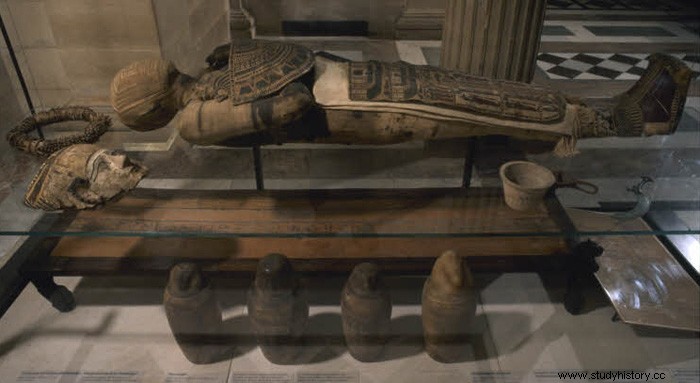
Mummification and funeral rituals:
The Egyptians believe that the dead continue to live in the afterlife. For them, life after death is far more important than earthly life. They believe that the body of the human person comprises several spiritual principles which are released after death and remain bound to the corpse. There is the Akh , which is a principle of immortality that only kings and gods possess. There is the ba which is independent of the body and which regains its freedom after death. Finally, the ka is the vital energy which, to perpetuate itself, needs a support:mummy, statue, image. Thus, a representation of the human person in his daily life, allows his ka to live in this way. In the Middle Kingdom, the heart will be added to these spiritual principles. To prevent the bodies from decomposing, they are embalmed:The brain is removed using hooks passed through the nostrils of the dead, the left side of the body is incised using a flint knife and the viscera are removed. Like the brain, they are kept in funerary vessels called canopes. Then, the inside of the body is stuffed with linen cloth, natron, sawdust and scented spices, it is sewn up, covered with aromatics and immersed in a bath of natron (salt) intended to dry it out for 70 days. . Then it is wrapped in several layers of long, thin strips of canvas dipped in a fragrant resin. Texts, jewels and amulets are placed between the cloths. The priests touch the ears, nose and mouth of the pharaoh with magical instruments that guarantee him the use of his senses in the afterlife, then a mask is placed on the face of the mummy. During the Old Kingdom , only the pharaohs had the right to such rituals.
Book of the Dead:
These are rolls of papyrus, covered with funerary formulas, placed near the mummy or against it in the wrappings. The various copies of the Book of the Dead are not all identical and the beneficiary can choose the formulas that suit him according to what he can afford. Indeed, the texts reproduced in the manuscripts represent an important financial, material, spiritual and moral investment. Some manuscripts may therefore be short, while others reproduce all, or almost all, of the text.
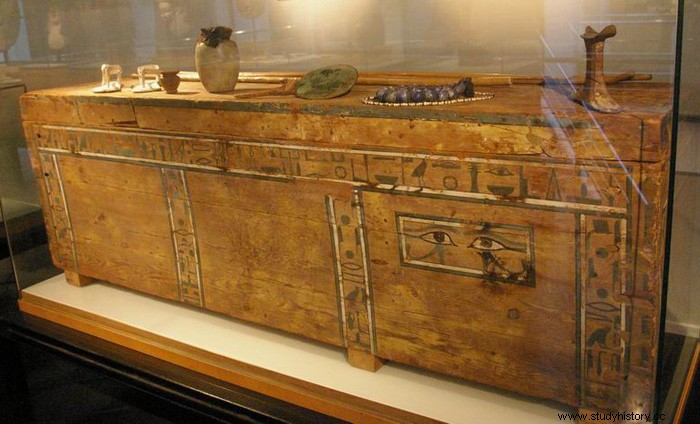
Sarcophagi:
The mummies are placed in sarcophagi . The first sarcophagi were simple wooden boxes. Later, during the New Kingdom, the mummies would be placed in two or three human-shaped coffins, nested inside each other, and often painted in bright colors. (In the photo: :Wedjat eyes drawn in a rectangle, allow the deceased to look outwards. Objects of everyday life are positioned on the lid of the sarcophagus to accompany the deceased in the afterlife. Here we find a wooden bedside table, a necklace, a copper mirror, cosmetic vases, a pair of sandals.)
The tombs:
The sarcophagi of wealthy Egyptians are placed in tombs filled with precious objects. During the Old and Middle Kingdoms, the Egyptians built huge tombs called pyramids for the pharaohs. They are the symbol of ancient Egyptian civilization and they represent the power held by the pharaohs. There are more than thirty in Egypt. To build his “abode of eternity” seems to have been an obsession of the sovereigns of this time.
Sacred texts:
During the funeral, the priests recite long religious texts to allow the pharaoh to ascend to heaven and be assimilated to the gods with whom he will live for eternity. Thus purified, he will be able to enjoy the offerings of the gods and will be protected from the dangers of the world of the dead, from the bites of snakes and evil spirits. From 2470 BC. J.-C., under the reign of Pharaoh Ounas, the sacred and “magical” texts will also be engraved on the walls of the pyramids.
Transformation of the pharaoh for his life in the afterlife:
The pyramids are built with several pieces that each have a specific function. In the sarcophagus chamber, the pharaoh becomes a new Osiris and assimilates himself to Atum, god of the setting sun. In the antechamber, he prepares for navigation and becomes god of the sky. In the corridor, the transformed pharaoh sees the locks of his tomb open in front of him, he can then settle in his solar boat (built for him and placed in his tomb) to cross the kingdom of Osiris and make his journey. to the afterlife.
AROUND 2,700 BC. AD
Building fever:
In the 4 corners of the world, men experience the fever of building. On the banks of the Indus as on the eastern bank of the Nile, from Sweden to the island of Malta, along the coasts of Europe, are built cities, pyramids, temples and dolmens. These monuments remain so many question marks on the science and spirituality of the men who lived at that time. Many questions remain:Why have you spent so much energy at a time when daily bread was far from assured? Why did the Egyptians feel, with the whip to punctuate their effort or by simple voluntary contribution, the need to carry blocks of several tons over thousands of kilometers? In the history of the world, there is no other comparable example of such a fury to build.
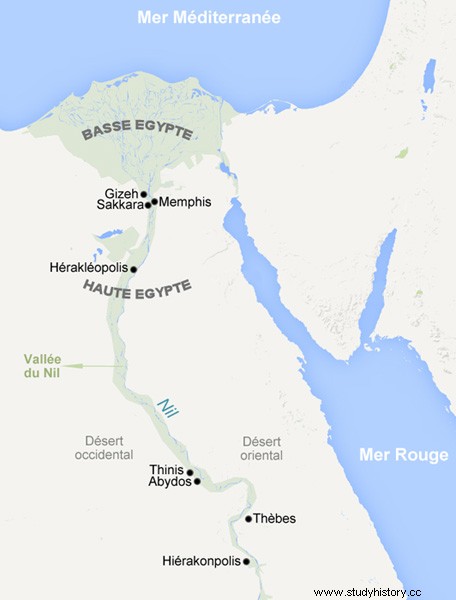
TOWARDS 2,691 B.C. AD (DATE UNCERTAIN)
Construction of the first step pyramid:
The famous pharaoh Djoser asks his vizier and architect Imhotep to build him his “abode of eternity” in Saqqara. The visible part of the tomb is originally a traditional rectangular mastaba 8 meters high and covered with white limestone. The building is built with stones that resist time better than raw bricks. The burial chamber, where the pharaoh's sarcophagus will be deposited after the funeral rituals, is located 28 meters deep and is accessible by a long corridor. This corridor is then closed by a block of 3.5 tons, which however will not prevent the tomb from being looted. Many other chambers are dug around the main vault, and after the death of the pharaoh, nearly 40,000 vases, plates, cups, dishes as well as food and drinks will be deposited there. Imhotep enlarged the mastaba and surrounded it with an enclosure 1,600 meters long, decorated with 14 false doors. Only one, narrow, allows access to the building, but it has no leaf and is guarded night and day. He had small temples, chapels and courtyards built there to make a funerary complex that would allow the pharaoh to reign in the afterlife. So that the complex is visible above the enclosure, Imhotep raises it by adding five superimposed constructions, each smaller than the previous one:the first step pyramid was born! It rises to 60 meters tall and is made up of thousands of stones carved by workers. The pyramid symbolizes a staircase drawn up towards the sky and manifests the pharaoh's aspiration to rise towards the gods.
TOWARDS 2,625 B.C. AD (DATE UNCERTAIN)
First pyramid with smooth faces:
Snefrou had his eternal home built 20 km from Saqqara. If Snefrou is benevolent for the people, his successors are described as cruel tyrants, although their internal politics are unknown to us. Herodotus (Greek historian born in 484 BC) wrote the dreadful tales told by the Egyptians of the cruelty of Cheops and Khrephen.
AROUND 2,600 B.C. AD (DATE UNCERTAIN)
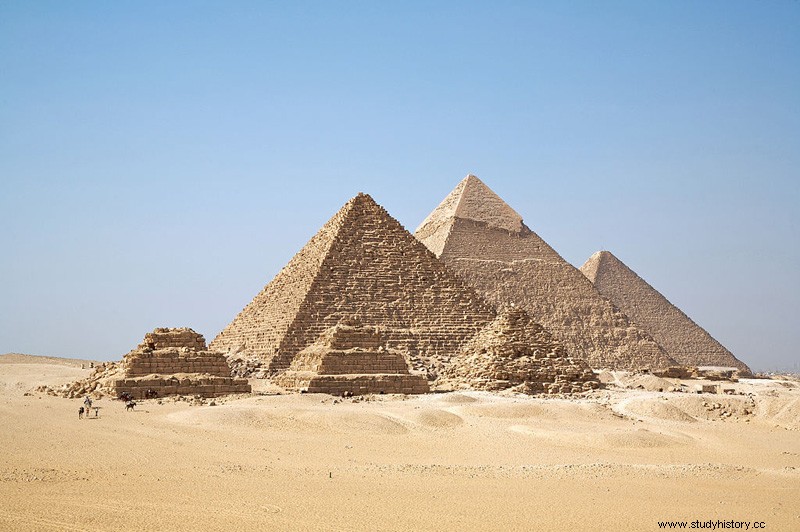
Construction of the Giza pyramids:
The most famous pyramids are at the center of a vast funerary complex at Giza , near Memphis . The largest was built by the pharaoh Cheops, son of Snefrou. It measures 147 m high and comprises more than 2 million stone blocks . It shone in the desert before the inhabitants of the region used the stones of the coating for their own constructions. Then his son Khrephen had his own built next to his father's. It is 144 meters high and narrower. And finally Mykerinus, son or brother of Khrephen, had the smallest of the 3 built, which is “only” 62 meters high. The 3 pyramids are geometrically perfect . The Egyptian engineers of the time were able to raise such monuments with very rudimentary means. The construction methods of the Egyptian pyramids remain uncertain.
AROUND 2,550 B.C. AD (DATE UNCERTAIN)
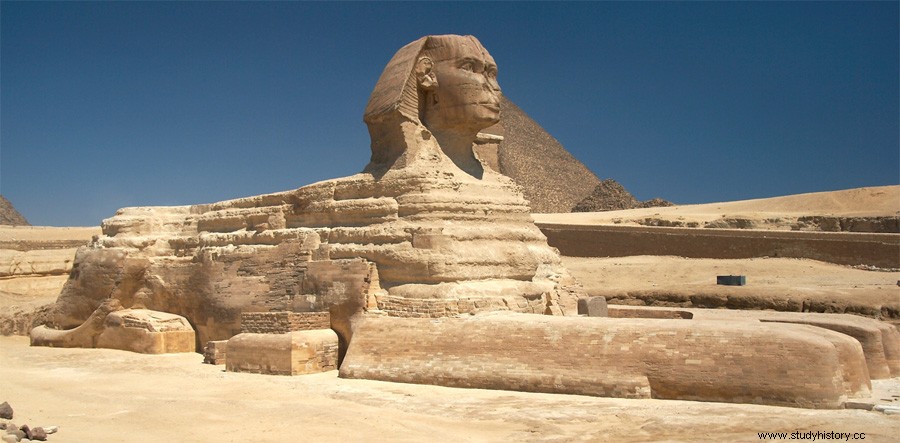
Construction of the Great Sphinx:
Khrephen would also have built the Great Sphinx , but no element connects it either to the Great Pyramid, or to the monuments of this pharaoh. Moreover, the representation of the lion's body with the human head reverses the visions that the Egyptians have of their gods:a human body with an animal head. Some attribute this colossal monument to the ancient Egyptian people who built it as a tribute to the first great pharaoh Osiris. The Sphinx is wearing the nemes , like the dead pharaoh, his lion body is 20 meters high and 71 meters long. He is the largest of the many tawny sphinxes that watch over the world of the dead.
Egypt and its neighbors:
Through expeditions across the borders, the pharaohs ensured the security of Egypt and increased its wealth. In Nubia , inscriptions attest to the passage of the armies of the pharaohs Sanakht, Kheops, Sahourê, Neousserê, Pepi I and Pepi II. Snefrou undertakes expeditions to Nubia against the Libyans , and at Sinai where he has turquoises mined. During the Old Kingdom, raids by Palestinians and Bedouins from Asia are repulsed, and the protection of boats coming from Lebanon with precious wood, essential for construction, is ensured.
AROUND 2,260 B.C. AD
End of the Old Kingdom:
During the 5 centuries of the Old Kingdom, the absolute authority and the power that the pharaohs wielded over the people slowly waned. It has become difficult to maintain a centralized administration and the nomarchs (administrators of provinces) began to challenge the supremacy of the pharaohs by marrying their daughters for example. Pepi II is the last pharaoh of the Old Empire, too lenient, he was unable to break the growing independence of high dignitaries and nomarchs who begin to found real lordships and independent principalities.
Dynasties and list of pharaohs during the Old Kingdom:
Third Dynasty (2778 to 2723 BC)
Djoser (First step pyramid), Sekhemkhet, Sanakht or Nebka, Khaba, Nerferka, Hou or Houni.
Fourth Dynasty (2723 to 2563 BC)
Snefrou , Cheops (first great pyramid) , Didoufri or Dedefre, Krephren , Mykerinus , Shepsekaf.
Vth dynasty (2563 to 2420 BC)
Userkaf, Sahurê, Neferirkare, Shepsekare, Neferefrê, Neousserê, Menkauhor, Isesi, Unas.
VIth dynasty (2420 to 2260 BC)
Téti, Userkaré, Pepi I, Merenrê, Pepi II (the longest reign in Egyptian history).
